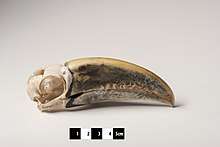Green-billed toucan
The green-billed toucan (Ramphastos dicolorus), or red-breasted toucan, is a near-passerine bird in the family Ramphastidae found in southern and eastern Brazil, Pantanal of Bolivia, eastern Paraguay and far north-eastern Argentina. It is primarily found in the Atlantic Forest. Overall, it is fairly common, and therefore considered to be of least concern by IUCN.[1]
| Green-billed toucan | |
|---|---|
.jpg) | |
| In Parque das Aves, Brazil | |
| Scientific classification | |
| Kingdom: | Animalia |
| Phylum: | Chordata |
| Class: | Aves |
| Order: | Piciformes |
| Family: | Ramphastidae |
| Genus: | Ramphastos |
| Species: | R. dicolorus |
| Binomial name | |
| Ramphastos dicolorus | |
| Synonyms | |
| |
It is one of the smallest species of Ramphastos toucans, weighing 265–400 grams (9.4–14.2 oz.) and measuring 40–46 cm (16–18 in) long in total.[2] Its beak is one of the shortest of Ramphastos toucans at only about 10 cm (4 in) in length. Its breast is actually orange, with yellow at the sides. The beak is mostly pale greenish-horn, leading to its common name. In aviculture, their requirement of spacious cages, a high fruit diet and sensitivity to hemochromatosis (iron storage disease) make them difficult to maintain for novice keepers.

References
- BirdLife International (2012). "Ramphastos dicolorus". IUCN Red List of Threatened Species. 2012. Retrieved 26 November 2013.CS1 maint: ref=harv (link)
- "Archived copy". Archived from the original on 2007-08-19. Retrieved 2007-08-18.CS1 maint: archived copy as title (link)
External links
| Wikimedia Commons has media related to Ramphastos dicolorus. |
- Extensive Gallery on Toucans
- List of Toucans
- Toucan videos on the Internet Bird Collection
